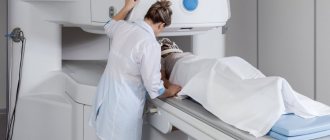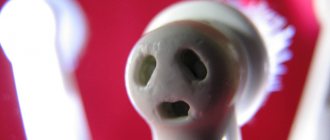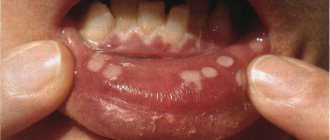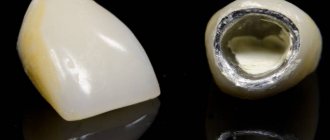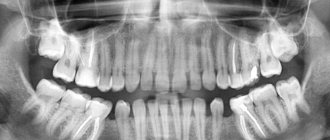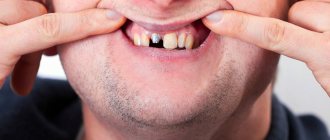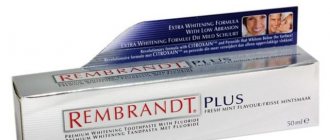What is MRI?
This name is fully deciphered as magnetic resonance imaging. Due to the fact that it does not use X-ray radiation, it is considered as safe as possible for human health. But at the same time it makes it possible to see all the internal organs, systems and tissues of the patient in various sections and planes in the form of a three-dimensional image.
This helps to accurately establish a diagnosis, detect tumors and other formations, examine the brain, the functioning of the musculoskeletal system, and also monitor the dynamics of chronic diseases. And since there is no harmful radiation, even with multiple examinations, MRI is not considered dangerous to humans.
It is carried out as follows:
- the patient lies down on a special table;
- it is pushed into a large cylindrical scanner;
- you need to lie still, you can put on headphones so as not to hear the unpleasant sound from radio waves;
- The doctor adjusts the image quality and takes the required images of individual organs.
The entire procedure can take from 10 to 30 minutes, depending on what exactly is being examined. The patient is able to report his condition thanks to the microphone built into the device and hear the doctor’s instructions.
Such an examination is prescribed for head injuries, suspected malignant formations in various parts of the body, serious disorders of the blood vessels, brain aneurysm, problems with the pituitary gland, etc.
This study is one of the most complete and high-quality, making it possible to immediately make a diagnosis and prescribe effective treatment. Any other devices do not provide such accuracy, and even when combining several indicators, they do not always help the doctor determine the root cause of the disease.
The main contraindications to MRI are:
- pacemakers;
- ferromagnetic materials in orthodontic structures;
- tattoos made using special dyes;
- clips on vessels installed to regulate blood flow.
Manufacturing materials
Many different materials are used in dental and orthodontic practice. Some of them may affect the results of a magnetic resonance imaging study, while others may not. But in any case, the presence of crowns, implants or braces will not harm the patient’s health during tomography.
- If the patient has modern metal-ceramic crowns installed, then their alloy will have almost no effect on the MRI results. Therefore, if such products are present in the mouth, it is quite acceptable to carry out all the required examinations.
- But when prosthetics were performed more than ten years ago, other alloys were used at that time - mostly copper, nickel, iron, chromium, and steel. These designs can distort the results of tomography and lead to the fact that an expensive examination will be ineffective.
- If pins or implants are installed, then what materials they are made of is also of great importance. Thus, with a titanium base, the blurriness of the images will be minimal, and if the alloy contains other metal components, this will be reflected in the quality of the diagnosis.
Types of material for dental structures and MRI
The answer to the question whether or not it is possible to carry out resonance tomography with dental implants directly depends on which of the materials was used in the prosthetics process. Some time ago, structures of this type were made of metal, as a rule, an alloy of gold, copper and steel was used. This composition may not have a significant effect on MRI, but the picture that is obtained during the study is not very clear. Currently, implants made of metal-ceramics are used in dentistry. With them you can undergo MRI without any problems, the quality of the image will not be spoiled at all.
If there is pain, the procedure may still need to be done.
Not only the material of the crown matters, but also the bases from which all the parts are made, that is, the pins and screws. Each such element is made of paramagnetic, ferromagnetic and diamagnetic material. Such bases can influence the magnetic field created by MRI machines. These are special materials that, under the influence of the magnetic field present in tomography equipment, can heat up and move. For this reason, before the examination it is worth checking the shape of the dental structures that stand, their strength and the reliability of their fastening.
Warn the doctor
And although there will be no harm to the person with installed braces, implants or dentures, it is still necessary to warn the doctor in advance about the presence of foreign objects in the mouth. Especially if they contain metal in any quantity and form.
The fact is that such fragments will affect the quality of the resulting image, make the pictures blurry, and it will not be possible to carry out an accurate diagnosis. But in each case, the specialist himself will decide whether dental structures in the patient’s mouth interfere with him or not. So, when examining the abdominal cavities or below the waist, the presence of any metal products does not matter. And if an MRI of the brain is required, then this must be taken into account.
In some cases, the doctor can make certain adjustments to the device in accordance with the location of individual crowns or implants and thus obtain better results. But such moments are always considered on an individual basis.
Features of magnetic resonance therapy of patients with dentures
If a person with removable dentures is shown an MRI image, then there is no problem at all. I took off the prosthesis, went through the procedure and put it back on. In addition, pins, prostheses or implants made of titanium, gold or similar neutral materials are safe. Prostheses made of nickel, chromium and steel can cause distortion in the images.
Braces
Metal structures are installed to correct the appearance and bite of teeth. When diagnosing with a tomograph, they have a big drawback - a large impact area, which can lead to serious distortion of the study results.
When prescribing such a procedure, the patient will have to temporarily stop wearing braces, especially if we are talking about identifying an aneurysm or brain tumor.
Pins and implants
Another type of metal structures is Ankylose crowns or implants. They are usually mounted on iron or titanium pins. The materials from which these dental structures are made are inert, which means they are not harmful to the body, but are extremely undesirable when performing tomography.
Is it possible to do an MRI with dental implants? This question is not clear-cut. If diagnostics are required for the abdominal cavity and other organs located below the lower back, then the presence of prostheses will not have any effect on the image.
When diagnostics is required for organs located above the lower back, in the neck, pituitary gland, brain and chest, serious distortions in the final tomography result can occur here. But you should understand that any examination has to be done with them, i.e. Removing dental structures and installing them again is not a cheap pleasure.
Metal prostheses
Each patient, when installing implants, should know for himself in the future what raw materials the product is made from. If it contains metal or metal-ceramics, then the doctor who will perform the MRI should be warned about this.
Let's dispel the myth - a prosthesis attached to hard bone tissue does not shift in any way under the influence of radio waves, but the result of the study will be slightly distorted.
If the medical institution has the appropriate equipment, the doctor can adjust the tomograph settings so that the negative impact from the tomograph is minimal. In addition, you can use another diagnostic option, for example, CT.
Is it possible to do an MRI with dental implants?
When installing any implants, dentists usually give the patient a special passport, which indicates the materials and alloys on which all the parts are made. By showing them to the doctor, you can accurately predict whether you should worry about their presence during an MRI or not.
It should be noted that modern implants are created from inert and biocompatible substances. They are completely safe and non-toxic for the human body. But in relation to a magnetic apparatus, they can significantly distort the results obtained, since they enter into a certain reaction with its fields.
If such elements are present in the mouth, the doctor may ask you to bring an x-ray with their exact location. This will make it easier to set up the device for image correction. Although in some cases it is necessary to abandon such an examination and choose a different method of diagnosis.
What about crowns?
The situation is a little simpler with crowns. The materials used to make them are quite varied. Thus, if modern metal-ceramic or ceramic products are installed, they have almost no effect on the quality of the MRI examination.
And you need to approach this completely differently if such prostheses were installed more than ten years ago. Then they also used gold, steel, copper and other metals, which significantly distort the resulting image. Therefore, the doctor must be warned about their presence.
MRI while wearing braces
Many patients are frightened by scary stories that during magnetic resonance imaging, braces can spark, heat up, explode, shock a person, etc. This is all untrue, and even if there are metal structures in the mouth, their interaction with the magnetic apparatus remains safe for the body .
Still, it is not advisable to do an MRI with braces installed, especially if they have a metal base. This will affect the results of the images and make such an expensive procedure completely useless. Their main problem is the large volumes of occupied space, which, when studying the brain, will lead to almost complete distortion of the information obtained.
But there is a way out - if there is a strong need to conduct high-quality diagnostics using MRI, you can do the following. Before the procedure, go to the dentist or orthodontist who installed the braces and ask him to remove them for one day. After the examination, fix them in their original place.
For which implants MRI is not performed?
There is a certain list of implants, the presence of which in the human body is generally contraindicated for MRI. Even if the material from which they are made allows this.
- The presence of particularly large metal implants in the patient’s body.
- The presence in the body of hemostatic clips in the vessels.
- Maintaining the patient's heart activity using a pacemaker.
- Fragments of bone tissue are fastened with the Elizarov apparatus.
- There is an implant in the patient's middle ear.
- There are ferromagnetic fragments in the patient's body.
The study is not carried out in the presence of metal implants in the bones
It is worth considering the case when a patient has a pin in a tooth and needs an MRI of the brain. This question is quite popular, since the vast majority of patients may have pins in their teeth or simply crowns. MRI with fiberglass or ceramic pins can be done completely safely. But if the pin is made of titanium, gold or platinum alloys, you must inform your doctor about this. The doctor will adjust the sensitivity of the device accordingly, this will avoid possible interference in the resulting images. The result will be accurate, without possible distortion. If this is not done, then pictures in places where there are foreign metal elements may be blurry.
There are also a number of contraindications when performing MRI of the brain:
- First of all, this is the fear of closed spaces. If there are metal parts in the body, it may become stronger due to the appearance of magnetic waves.
- Serious heart disease, use of pacemakers. During the procedure, the patient's heart may not withstand the overload and stop.
- MRI is absolutely not allowed in patients with multiple sclerosis.
- A doctor may not allow a patient with tattoos to undergo a scan. When applying the design, dyes containing metal could be used.
From this video you will find out whether it is possible to do MRI with dental implants:
Dental pins
Such elements are part of implants or are installed to fix individual units in the mouth. In any case, they are made of metal, so they significantly worsen the results of magnetic resonance imaging. If they are made of titanium without various impurities, then it is quite acceptable to conduct a similar diagnosis. But it is necessary to warn the doctor about such elements in the mouth.
Obviously, removing them and then installing them again is irrational and very expensive. In addition, such unnecessary intervention in the body can lead to rejection of the material and a deterioration in the patient’s health. Therefore, MRI will have to be done with these installed products or canceled altogether.
Video: how does MRI work?
Impact of implants on efficiency
An unpleasant aspect is distortions and inaccuracies in diagnostic results. But this does not mean that you do not need to undergo an examination. Simply, before starting the procedure, inform your doctor about the prostheses so that he can change certain settings. This way the image will be clear and there will be no defects. The client should show the diagnostic doctor the results of an X-ray examination of the jaws. This image clearly shows the dental structures.
If you experience pain when chewing food, spasms when opening and closing your mouth, involuntary jaw movements and unusual sounds, be sure to contact your dentist. Artificial roots of units are not an obstacle to a full examination. Innovative equipment with advanced technology completely eliminates risks for the patient. On the page of our website, the cost of dental implantation, contains detailed information on prices and tariffs, as well as a detailed description of the operating features of the tomograph installed in the center.
Results
Almost all modern materials used to create orthodontic and dental structures are safe for the body. And even if there is metal in the alloy, they do not lead to serious violations or consequences during the examination process. They also do not damage the device itself, since they are too small.
If the products are removable or can be temporarily removed from the mouth in the dentist's office, then it is better to take advantage of this and come for an examination without foreign objects in the mouth. Thus, it is possible to obtain the required diagnostic results, and only then re-install the treatment structures.
But if there are some components in the composition, there is still a risk of distorting the tomography results. The doctor will take into account the amount of metal used, its composition, what part of the body needs to be diagnosed and the ability to configure the device. As a result, it will give an answer as to whether it is worth performing an MRI in your case or whether it is better to choose another diagnostic procedure.
Distortion of results is the only reason for concern
The importance of warning the doctor about the presence of implants in a patient is due to the fact that they can cause distortion of the tomography result.
But this does not make the presence of artificial roots a contraindication for MRI. A knowledgeable specialist will be able to configure the device in such a way that the images will be as clear as possible, even with implants. To do this, you need to provide the doctor with an x-ray of the jaws, where you can easily familiarize yourself with the location of the titanium rods.
You should also be aware that distortions can only be caused by the presence of implants if the neck and head are checked on an MRI. If the chest is being examined, distortion may be minor. They will depend on the material of the crowns and the characteristics of the device used. If the lower spine and legs are examined, then no metal inserts in the oral cavity will cause damage to the quality of the images.
